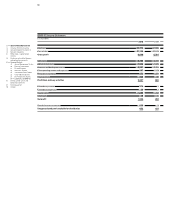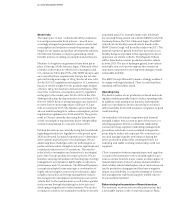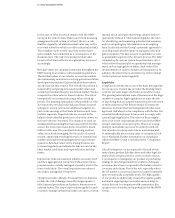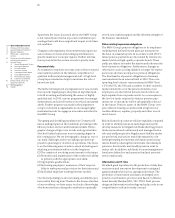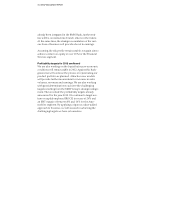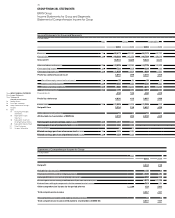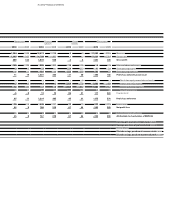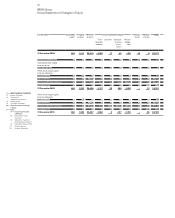BMW 2010 Annual Report Download - page 72
Download and view the complete annual report
Please find page 72 of the 2010 BMW annual report below. You can navigate through the pages in the report by either clicking on the pages listed below, or by using the keyword search tool below to find specific information within the annual report.
70
12 GROUP MANAGEMENT REPORT
12 A Review of the Financial Year
14 General Economic Environment
18 Review of Operations
41 BMW Group – Capital Market
Activities
44 Disclosures relevant for takeovers
and explanatory comments
47 Financial Analysis
47 Internal Management System
49 Earnings Performance
51 Financial Position
53 Net Assets Position
55 Subsequent Events Report
55 Value Added Statement
57 Key Performance Figures
58 Comments on BMW AG
62 Internal Control System and
explanatory comments
63 Risk Management
70 Outlook
Outlook
The economic environment in 2011
We think it likely that the global economic upswing that
began in the second half of 2009 will continue during
2011, albeit with a significantly lower rate of growth. Some
persisting risks could, however, result in temporary set-
backs for the global economy.
Economic growth in the USA is again predicted to be
moderate in 2011. The slow recovery of the employment
and real estate markets as well as the high level of debt
inprivate households is likely to dampen consumer
spending in the USA in 2011 compared with the years
before the crisis. The strongest contribution to growth is
more likely to come from private investment, while ex-
ports are set to drop slightly.
Economic growth in Europe as a whole will remain lower
than in the USA. Germany will again be the economic
driving force in the region, although to a far lesser degree
than in 2010. Whereas exports are being affected by the
slowing down of the global economy, domestic demand
is proving to be quite robust thanks to positive trends
onthe employment market. The French economy will
continue to grow at a similar pace and hence somewhat
slower than in Germany. In Italy growth is likely to
remain modest, whereas Spain’s economy should grow
in2011 for the first time in four years, even if the situa-
tion
as a whole remains weak in the face of high unem-
ployment
and downward adjustments on the property
market. In contrast, markets in the UK are likely to grow
robustly again in 2011, despite the government’s drastic
saving plans.
The slow-down of the global economy and the strong yen
could well hold down Japan’s exports compared with
the past year. Consumer spending will also rise only
moderately after the strong performance in 2010, which
could well lead to significant slowing down, thus fuelling
deflation.
The prime drivers of global economic growth will again
be the emerging markets in Asia, Latin America and
Eastern Europe, with China and India at the forefront.
China’s government is likely to undertake massive efforts
in 2011 to keep the lid on the economic growth rate,
particularly for investment activities, while simultane-
ously
attempting to encourage private spending. Al-
though
still at a high level, growth in China could well
see a slowing down in 2011. With the pace of growth in
India continuing unabated, the economies of the two
countries are set to expand similarly in 2011. The
econ-
omy in Brazil is also set to cool down slightly in 2011
after an exceedingly good performance over the past
year. Russia, too, will probably grow at a marginally lower
rate than in the years prior to the financial crisis.
Euro set to remain strong
The US dollar is expected to remain slightly undervalued
in 2011. The loss in confidence in the euro caused by
the
turmoil on European state bond markets should pre-
vent another collapse of the US dollar. Low interest
rates, public budget and current account deficits are all
likely to have a negative impact on the US currency.
The
British pound continues to be weak against the euro.
However, as the economy recovers, it could well gain
invalue in the long term. The Japanese yen should re-
main strong against the euro in 2011 due to the fact that
it continues to be seen as a safe investment and to bene-
fit from Japan’s current account surplus. Bearing in
mindthehigh liquidity surpluses still being generated on
emerging markets, it is likely that currencies here will
remain strong against the US dollar and the euro.
Car markets in 2011
International car markets should continue to expand in
2011, although somewhat less dynamically than in the
past year. China, currently the world’s largest car market,
is forecast to grow somewhat more slowly than in the
past two years. Recovery in the USA is set to continue
gradually in 2011, similar to the rate recorded in 2010.
In the European Union, the situation is expected to return
to a normal level, now that the effects of state-funded
stimulus programmes are coming to an end. Overall, the
region’s economy should grow slightly, largely on the
back of economic recovery in Eastern Europe. The picture
in Western Europe still varies greatly from country to
country. Whereas Germany is expected to grow again
after the setback caused by the expiry of the scrappage
bonus scheme, the car market in France is expected to con-
tract
again in 2011. Markets in the UK, Italy and Spain are
forecast to tread water to a large extent.
The Japanese market is also likely to stagnate after two
years of sales being driven by the state-sponsored stimu-
lus programme.
India could well see the fastest rate amongst the major
emerging markets, while growth in Brazil and Russia is
expected to be more moderate.


